27 Exponential Functions
Topics Covered:
Define and Evaluate Exponential Functions
The functions we have studied so far do not give us a model for many naturally occurring phenomena. From the growth of populations and the spread of viruses to radioactive decay and compounding interest, the models are very different from what we have studied so far. These models involve exponential functions.
An exponential function is a function of the form f(x) = ax where a > 0 and a ≠ 1.
Exponential Function
An exponential function, where a > 0 and a ≠ 1, is a function of the form
f(x) = ax
Notice that in this function, the variable is the exponent. In our functions so far, the variables were the base.
 Our definition says a ≠ 1. If we let a = 1, then f(x) = ax becomes f(x) = 1x. Since 1x = 1 for all real numbers, f(x) = 1. This is the constant function.
Our definition says a ≠ 1. If we let a = 1, then f(x) = ax becomes f(x) = 1x. Since 1x = 1 for all real numbers, f(x) = 1. This is the constant function.
Recall that the base of an exponential function must be a positive real number other than 1. Why do we limit the base a to positive values? To ensure that the outputs will be real numbers. Observe what happens if the base is not positive:
In fact, f(x) = (−4)x would not be a real number any time x is a fraction with an even denominator. So our definition requires a > 0.
Try it! – Identifying Exponential Functions
- Which of the following equations are not exponential functions?
Solution
By definition, an exponential function has a constant as a base and an independent variable as an exponent. Thus, g(x) = x3 does not represent an exponential function because the base is an independent variable. In fact, g(x) = x3 is a power function.
Recall that the base a of an exponential function is always a positive constant, and b ≠ 1. Thus, j(x) = (−2)x does not represent an exponential function because the base, −2, is less than 0.
2. Which of the following equations represent exponential functions?
- f(x) = 2x2 − 3x + 1
- g(x) = 0.875x
- h(x) = 1.75x + 2
- j(x) = 1095.6-2x
Solution
g(x) = 0.875x and j(x) = 1095.6-2x represent exponential functions.
Why do we limit the base to positive values other than 1? Because base 1 results in the constant function. Observe what happens if the base is 1:
- Let a = 1. Then f(x) = 1x = 1 for any value of x.
To evaluate an exponential function with the form f(x) = ax, we simply substitute x with the given value, and calculate the resulting power. For example:
Let f(x) = 2x. What is f(3)?
To evaluate an exponential function with a form other than the basic form, it is important to follow the order of operations. For example:
Let f(x) =30(2)x . What is f(3)?
Note that if the order of operations were not followed, the result would be incorrect:
Try it! – Evaluating Exponential Functions
- Let f(x) = 5(3)x + 1. Evaluate f(2) without using a calculator.
Solution
Follow the order of operations. Be sure to pay attention to the parentheses.
2. Let f(x) = 8(1.2)x – 5. Evaluate f(3) using a calculator. Round to four decimal places.
Solution
5.5556
Graphing Exponential Functions
By graphing a few exponential functions, we will be able to see their unique properties.
Try it!
- On the same coordinate system graph f(x) = 2x and g(x) = 3x.
Solution
We will use point plotting to graph the functions.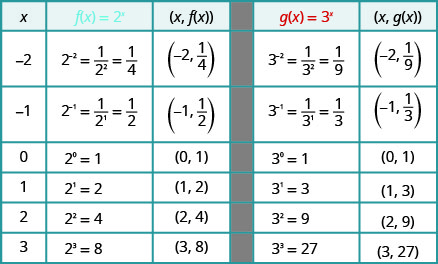
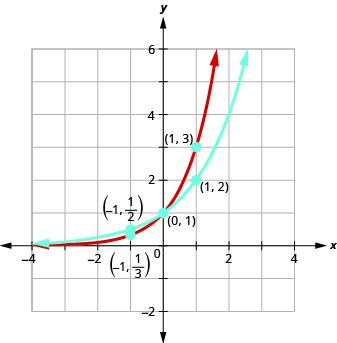
2. Graph: g(x) = 5x.
Solution
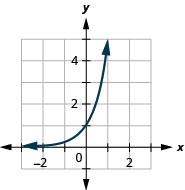
The graphs of f(x) = 2x and g(x) = 3x, as well as the graphs of f(x) = 4x and g(x) = 5x, all have the same basic shape. This is the shape we expect from an exponential function where a > 1.
We notice, that for each function, the graph contains the point (0, 1). This make sense because a0 = 1 for any a.
The graph of each function, f(x) = ax also contains the point (1, a). The graph of f(x) = 2x contained (1, 2) and the graph of g(x) = 3x contained (1, 3). This makes sense as a1 = a.
Notice too, the graph of each function f(x) = ax also contains the point ![]() . The graph of f(x) = 2x contained
. The graph of f(x) = 2x contained ![]() and the graph of g(x) = 3x contained
and the graph of g(x) = 3x contained ![]() . This makes sense as
. This makes sense as ![]() .
.
What is the domain for each function? From the graphs we can see that the domain is the set of all real numbers. There is no restriction on the domain. We write the domain in interval notation as (−∞, ∞).
Look at each graph. What is the range of the function? The graph never hits the x-axis. The range is all positive numbers. We write the range in interval notation as (0, ∞).
Whenever a graph of a function approaches a line but never touches it, we call that line an asymptote. For the exponential functions we are looking at, the graph approaches the x-axis very closely but will never cross it, we call the line y = 0, the x-axis, a horizontal asymptote.
Properties of the Graph of f(x) = ax when a > 1
| Properties | Definition |
| Domain | (−∞, ∞) |
| Range | (0, ∞) |
| x–intercept | None |
| y–intercept | (0, 1) |
| Contains | (1, a), |
| Asymptote |
x-axis, the line y = 0 |
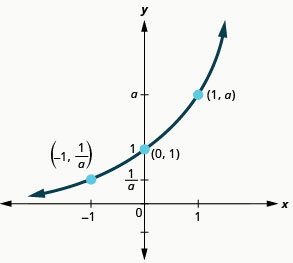
Our definition of an exponential function f(x) = ax says a > 0, but the examples and discussion so far has been about functions where a > 1. What happens when 0 < a < 1? The next example will explore this possibility.
Try it!
- On the same coordinate system, graph
 and
and  .
.
Solution
We will use point plotting to graph the functions.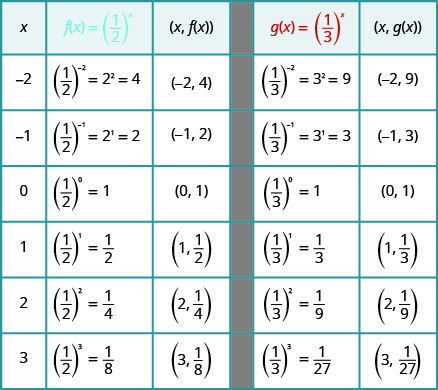
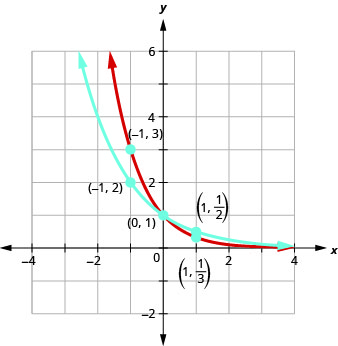
2. Graph: ![]() .
.
Solution
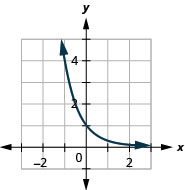
3. Graph: ![]() .
.
Solution
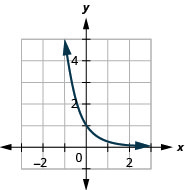
Now let’s look at the graphs from the previous Example and Try Its so we can now identify some of the properties of exponential functions where 0 < a < 1.
The graphs of ![]() and
and ![]() as well as the graphs of
as well as the graphs of ![]() and
and ![]() all have the same basic shape. While this is the shape we expect from an exponential function where 0 < a < 1, the graphs go down from left to right while the previous graphs, when a > 1, went from up from left to right.
all have the same basic shape. While this is the shape we expect from an exponential function where 0 < a < 1, the graphs go down from left to right while the previous graphs, when a > 1, went from up from left to right.
We notice that for each function, the graph still contains the point (0, 1). This makes sense because a0 = 1 for any a.
As before, the graph of each function, f(x) = ax, also contains the point (1, a). The graph of ![]() contained
contained ![]() and the graph of
and the graph of ![]() contained
contained ![]() . This makes sense as a1 = a.
. This makes sense as a1 = a.
Notice too that the graph of each function, f(x) = ax, also contains the point ![]() . The graph of
. The graph of ![]() contained (−1, 2) and the graph of
contained (−1, 2) and the graph of ![]() contained (−1, 3). This makes sense as
contained (−1, 3). This makes sense as ![]() .
.
We will summarize these properties in the chart below. Which also include when a > 1.
Properties of the Graph of f(x) = ax
| when a > 1 | when 0 < a < 1 | ||
|---|---|---|---|
| Domain | (−∞, ∞) | Domain | (−∞, ∞) |
| Range | (0, ∞) | Range | (0, ∞) |
| x-intercept | none | x-intercept | none |
| y-intercept | (0, 1) | y-intercept | (0,1 ) |
| Contains | (1, a), |
Contains | (1, a), |
| Asymptote | x-axis, the line y = 0 | Asymptote | x-axis, the line y = 0 |
| Basic shape | increasing | Basic shape | decreasing |
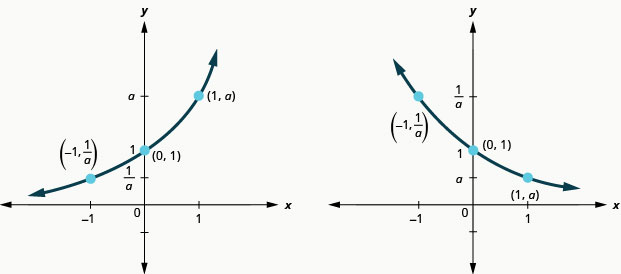
It is important for us to notice that both of these graphs are one-to-one, as they both pass the horizontal line test. This means the exponential function will have an inverse. We will look at this later.
Transformations
When we graphed quadratic functions, we were able to graph using translation rather than just plotting points. Will that work in graphing exponential functions?
Transformations of exponential graphs behave similarly to those of other functions. Just as with other parent functions, we can apply the four types of transformations—shifts, reflections, stretches, and compressions—to the parent function f(x) = ax without loss of shape. For instance, just as the quadratic function maintains its parabolic shape when shifted, reflected, stretched, or compressed, the exponential function also maintains its general shape regardless of the transformations applied.
The first transformation occurs when we add a constant c to the input of the parent function f(x) = ax, giving us a horizontal shift c units in the opposite direction of the sign. For example, if we begin by graphing the parent function f(x) = 2x, we can then graph two horizontal shifts alongside it, using c = 3 : the shift left, g(x) = 2x + 3, and the shift right, h(x) = 2x – 3. Both horizontal shifts are shown in the figure below.
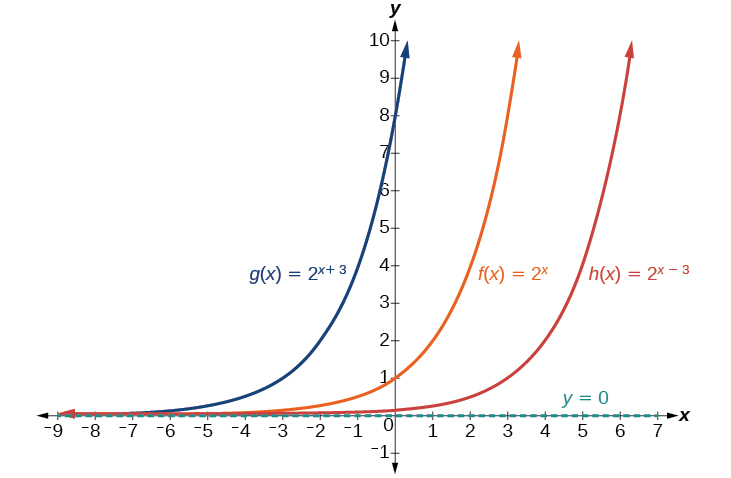
Try it!
- On the same coordinate system graph f(x) = 2x and g(x) = 2x + 1.
Solution
We will use point plotting to graph the functions.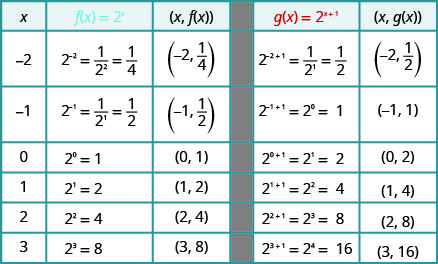
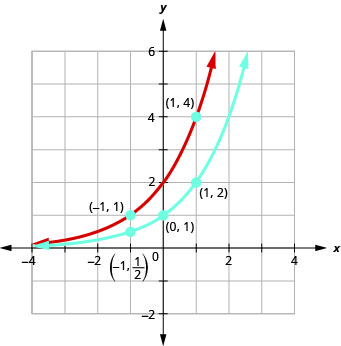
2. On the same coordinate system, graph: f(x) = 2x and g(x) = 2x – 1.
Solution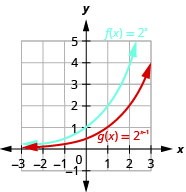
Looking at the graphs of the functions f(x) = 2x and g(x) = 2x + 1 in the last example, we see that adding one in the exponent caused a horizontal shift of one unit to the left. Recognizing this pattern allows us to graph other functions with the same pattern by translation.
The next transformation occurs when we add a constant d to the parent function f(x) = bx, giving us a vertical shift d units in the same direction as the sign. For example, if we begin by graphing a parent function, f(x) = 2x, we can then graph two vertical shifts alongside it, using d = 3 : the upward shift, g(x) = 2x + 3 and the downward shift, h(x) = 2x – 3. Both vertical shifts are shown in the figure below.
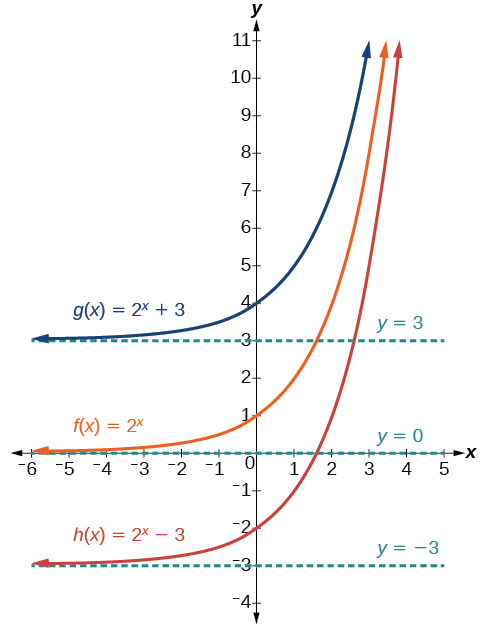
- The domain, (−∞,∞) remains unchanged.
- When the function is shifted up 3 units to g(x) = 2x + 3 :
- The y-intercept shifts up 3 units to (0, 4).
- The asymptote shifts up 3 units to y = 3.
- The range becomes (3, ∞).
- When the function is shifted down 3 units to h(x) = 2x − 3 :
- The y-intercept shifts down 3 units to (0, −2).
- The asymptote also shifts down 3 units to y = −3.
- The range becomes (−3, ∞).
Let’s now consider another situation that might be graphed more easily by translation, once we recognize the pattern.
Try it!
- On the same coordinate system graph f(x) = 3x and g(x) = 3x – 2.
Solution
We will use point plotting to graph the functions.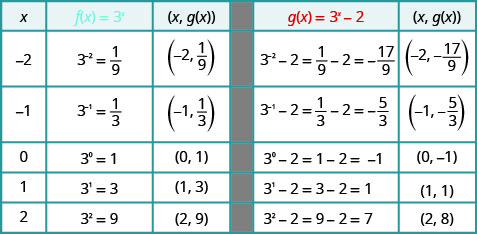
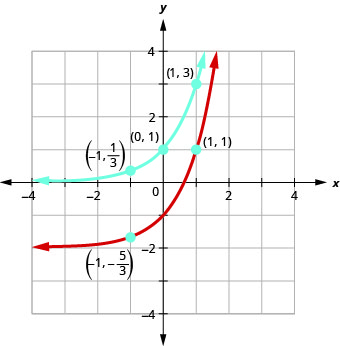
2. On the same coordinate system, graph: f(x) = 3x and g(x) = 3x + 2
Solution
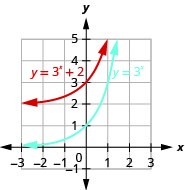
Looking at the graphs of the functions f(x) = 3x and g(x) = 3x – 2 in the last example, we see that subtracting 2 caused a vertical shift of down two units. Notice that the horizontal asymptote also shifted down 2 units. Recognizing this pattern allows us to graph other functions with the same pattern by translation.
For any constants c and d, the function f(x) = ax + c + d shifts the parent function f(x) = ax
- vertically d units, in the same direction of the sign of d.
- horizontally c units, in the opposite direction of the sign of c.
- The y-intercept becomes (0, ac + d).
- The horizontal asymptote becomes y = d.
- The range becomes (d, ∞).
- The domain, (−∞, ∞) remains unchanged.
Try it! – Graphing a Shift of an Exponential Function
Graph f(x) = 2x + 1 − 3. State the domain, range, and asymptote.
Solution
We have an exponential equation of the form f(x) = bx + c + d with b = 2, c = 1, and d = -3.
Draw the horizontal asymptote y = d, so draw y = -3.
Identify the shift as (-c, d) so the shift is (-1, -3).
Shift the graph of f(x) = bx left 1 units and down 3 units.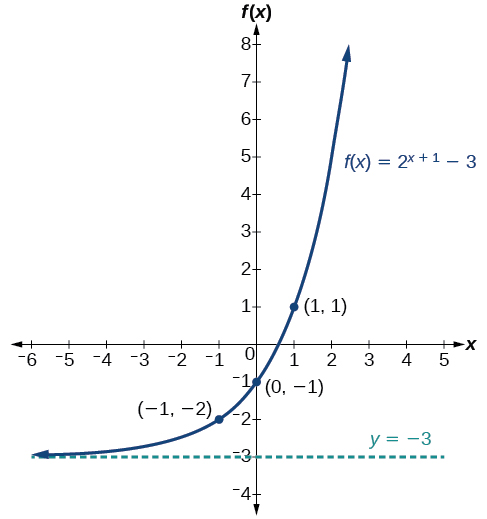 The domain is (−∞, ∞); the range is (−3,∞); the horizontal asymptote is y = −3.
The domain is (−∞, ∞); the range is (−3,∞); the horizontal asymptote is y = −3.
Stretch or Compress
While horizontal and vertical shifts involve adding constants to the input or to the function itself, a stretch or compression occurs when we multiply the parent function f(x) = ax by a constant |c| > 0. For example, if we begin by graphing the parent function f(x) = 2x, we can then graph the stretch, using c = 3, to get g(x) = 3(2)x as shown in the figure on the left, and the compression, using ![]() , to get
, to get ![]() as shown in the figure on the right.
as shown in the figure on the right.
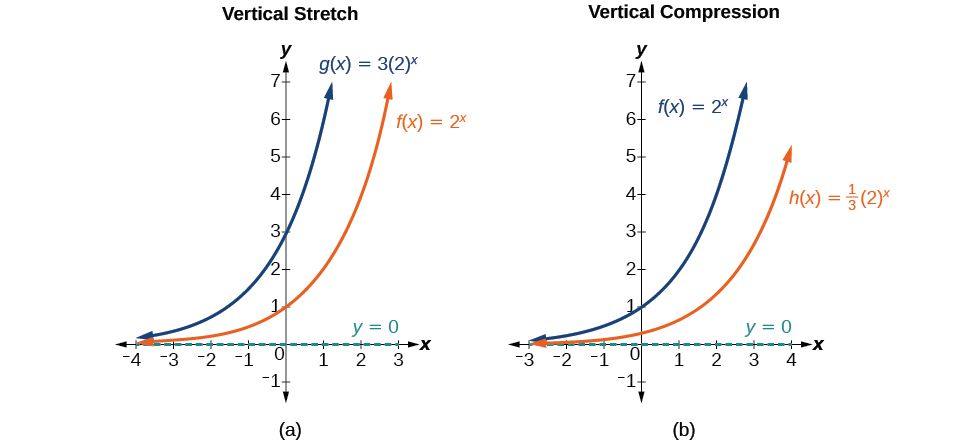
 compresses the graph of f(x) = 2x vertically by a factor of
compresses the graph of f(x) = 2x vertically by a factor of  .
.For any factor a > 0, the function f(x) = c(a)x
- is stretched vertically by a factor of c if |c| > 1.
- is compressed vertically by a factor of c if |c| < 1.
- has a y-intercept of (0, c).
- has a horizontal asymptote at y = 0, a range of (0, ∞), and a domain of (−∞, ∞), which are unchanged from the parent function.
Try it! – Graphing the Stretch of an Exponential Function
Sketch a graph of ![]() . State the domain, range, and asymptote.
. State the domain, range, and asymptote.
Solution
Before graphing, identify the behavior and key points on the graph.
- Since
 is between zero and one, the left tail of the graph will increase without bound as x decreases, and the right tail will approach the x-axis as x increases.
is between zero and one, the left tail of the graph will increase without bound as x decreases, and the right tail will approach the x-axis as x increases. - Since a = 4, the graph of
 will be stretched by a factor of 4.
will be stretched by a factor of 4. - Create a table of points as shown below.
xxx Points x −3 −2 −1 0 1 2 3 
32 16 8 4 2 1 0.5 - Plot the y-intercept, (0, 4) along with two other points. We can use (−1, 8) and (1, 2).
Draw a smooth curve connecting the points, as shown below.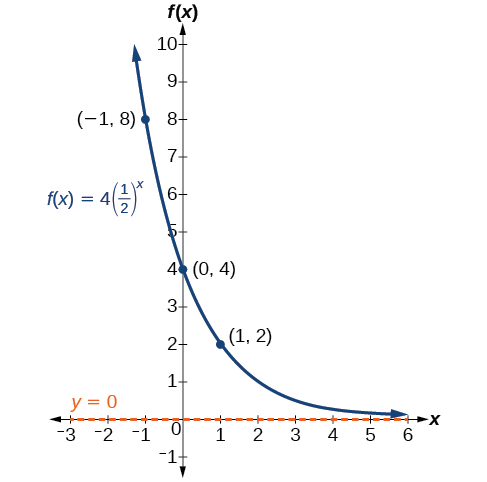 The domain is (−∞, ∞); the range is (0, ∞); the horizontal asymptote is y = 0.
The domain is (−∞, ∞); the range is (0, ∞); the horizontal asymptote is y = 0.
Reflections
In addition to shifting, compressing, and stretching a graph, we can also reflect it about the x-axis or the y-axis. When we multiply the parent function f(x) = ax by -1, we get a reflection about the x-axis. When we multiply the input by -1, we get a reflection about the y-axis. For example, if we begin by graphing the parent function f(x) = 2x, we can then graph the two reflections alongside it. The reflection about the x-axis, g(x) = -2x, is shown in the figure on the left side and the reflection about the y-axis h(x) = 2-x, is shown in the figure on the right side.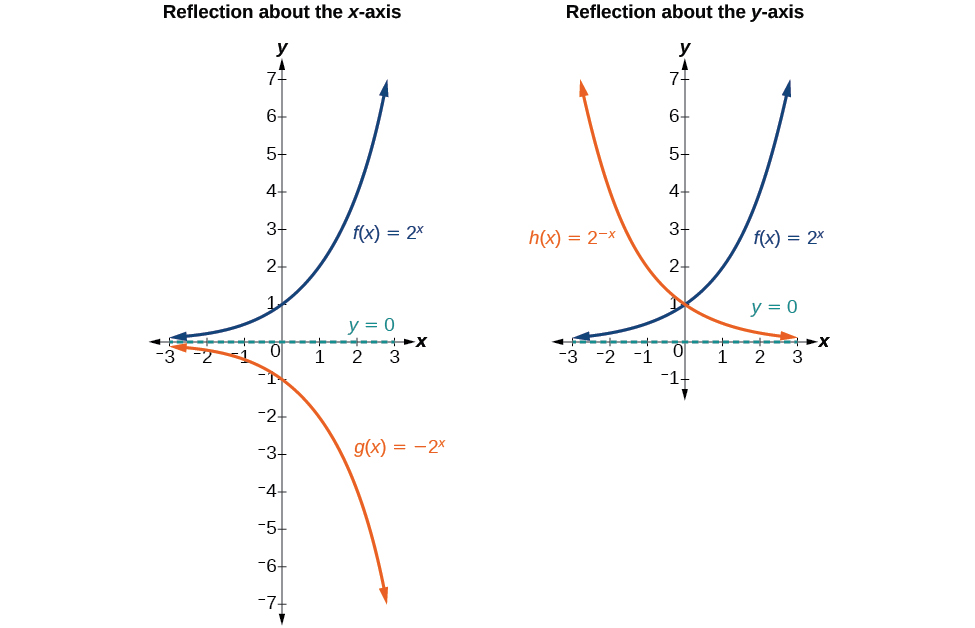
The function f(x) = −ax
- reflects the parent function f(x) = ax about the x-axis.
- has a y-intercept of (0, −1).
- has a range of (−∞, 0).
- has a horizontal asymptote at y = 0 and domain of (−∞, ∞), which are unchanged from the parent function.
The function f(x) = a-x
- reflects the parent function f(x) = ax about the y-axis.
- has a y-intercept of (0, 1), a horizontal asymptote at y = 0, a range of (0, ∞), and a domain of (−∞, ∞), which are unchanged from the parent function.
Try it! – Writing and Graphing the Reflection of an Exponential Function
Find and graph the equation for a function, g(x), that reflects ![]() about the x-axis. State its domain, range, and asymptote.
about the x-axis. State its domain, range, and asymptote.
Solution
Since we want to reflect the parent function ![]() about the x-axis, we multiply f(x) by -1 to get,
about the x-axis, we multiply f(x) by -1 to get, ![]() . Next we create a table of points as in the table below.
. Next we create a table of points as in the table below.
| xxx | Points | ||||||
| x | −3 | −2 | −1 | 0 | 1 | 2 | 3 |
| −64 | −16 | −4 | −1 | −0.25 | −0.0625 | −0.0156 | |
Plot the y-intercept, (0, −1), along with two other points. We can use (−1, −4) and (1, −0.25).
Draw a smooth curve connecting the points: The domain is (−∞, ∞); the range is (−∞, 0); the horizontal asymptote is y = 0.
The domain is (−∞, ∞); the range is (−∞, 0); the horizontal asymptote is y = 0.
| Translation | Form |
|---|---|
Shift
|
f(x) = bx + c + d |
Stretch and Compress
|
f(x) = abx |
| Reflect about the x-axis | f(x) = −bx |
| Reflect about the y-axis | |
| General equation for all translations | f(x) = abx + c + d |
Translations of Exponential Functions
A translation of an exponential function has the form f(x) = abx + c + d
Where the parent function, y = bx, b > 1, is
- shifted horizontally c units to the left.
- stretched vertically by a factor of |a| if |a| > 0.
- compressed vertically by a factor of |a| if 0 < |a| < 1.
- shifted vertically d units.
- reflected about the x-axis when a < 0.
Note the order of the shifts, transformations, and reflections follow the order of operations.
Natural Base e
All of our exponential functions have had either an integer or a rational number as the base. We will now look at an exponential function with an irrational number as the base.
Before we can look at this exponential function, we need to define the irrational number, e. This number is used as a base in many applications in the sciences and business that are modeled by exponential functions. The number is defined as the value of ![]() as n gets larger and larger. We say, as n approaches infinity, or increases without bound. The table shows the value of
as n gets larger and larger. We say, as n approaches infinity, or increases without bound. The table shows the value of ![]() for several values of n.
for several values of n.
| n | |
|---|---|
| 1 | 2 |
| 2 | 2.25 |
| 5 | 2.48832 |
| 10 | 2.59374246 |
| 100 | 2.704813829… |
| 1,000 | 2.716923932… |
| 10,000 | 2.718145927… |
| 100,000 | 2.718268237… |
| 1,000,000 | 2.718280469… |
| 1,000,000,000 | 2.718281827… |
The number e is like the number π in that we use a symbol to represent it because its decimal representation never stops or repeats. The irrational number e is called the natural base.
Natural Base e
The number e is defined as the value of ![]() , as n increases without bound. We say, as n approaches infinity,
, as n increases without bound. We say, as n approaches infinity,
e ≈ 2.718281827…
The exponential function whose base is e, f(x) = ex is called the natural exponential function.
Natural Exponential Function
The natural exponential function is an exponential function whose base is e:
f(x) = ex
The domain is (−∞, ∞) and the range is (0, ∞).
Let’s graph the function f(x) = ex on the same coordinate system as g(x) = 2x and h(x) = 3x.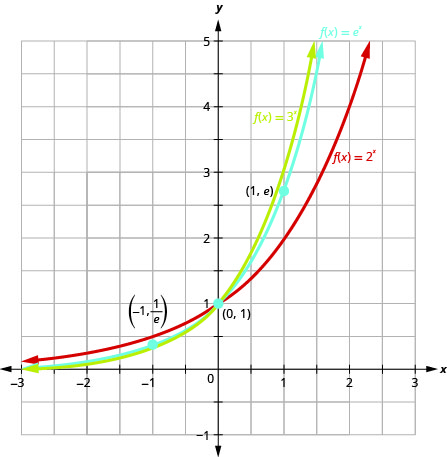 Notice that the graph of f(x) = ex is “between” the graphs of g(x) = 2x and h(x) = 3x. Does this make sense as 2 < e < 3?
Notice that the graph of f(x) = ex is “between” the graphs of g(x) = 2x and h(x) = 3x. Does this make sense as 2 < e < 3?
Use Exponential Models in Applications
Exponential functions model many situations. If you own a bank account, you have experienced the use of an exponential function. There are two formulas that are used to determine the balance in the account when interest is earned. If a principal, P, is invested at an interest rate, r, for t years, the new balance, A, will depend on how often the interest is compounded. If the interest is compounded n times a year we use the formula ![]() . If the interest is compounded continuously, we use the formula A = Pert. These are the formulas for compound interest.
. If the interest is compounded continuously, we use the formula A = Pert. These are the formulas for compound interest.
Compound Interest
For a principal, P, invested at an interest rate, r, for t years, the new balance, A, is:
![]() when compounded n times a year.
when compounded n times a year.
A = Pert when compounded continuously.
As you work with the Interest formulas, it is often helpful to identify the values of the variables first and then substitute them into the formula.
Try it!
- A total of $10,000 was invested in a college fund for a new grandchild. If the interest rate is 5%,how much will be in the account in 18 years by each method of compounding?
a. compound quarterly
b. compound monthly
c. compound continuously
Solution
| Steps | Algebraic |
| A = ? | |
| Identify the values of each variable in the formulas. | P = $10,000 |
| Remember to express the percent as a decimal. | r = 0.05 |
| t = 18 years |
a.
| Steps | Algebraic |
| For quarterly compounding, n = 4. There are 4 quarters in a year. | |
| Substitute the values in the formula | |
| Compute the amount. Be careful to consider the order of operations as you enter the expression into your calculator. | A = $24,459.20 |
b.
| Steps | Algebraic |
| For monthly compounding, n = 12. There are 12 months in a year. | |
| Substitute the values in the formula. | |
| Compute the amount. | A = $24,550.08 |
c.
| Steps | Algebraic |
| For compounding continuously, | A = Pert |
| Substitute the values in the formula. | |
| Compute the amount. | A = $24,596.03 |
2. Angela invested $15,000 in a savings account. If the interest rate is 4%, how much will be in the account in 10 years by each method of compounding?
a. compound quarterly
b. compound monthly
c. compound continuously
Solution
a. $22,332.96
b. $22,362.49
c. $22,377.37
Other topics that are modeled by exponential functions involve growth and decay. Both also use the formula A = Pert we used for the growth of money. For growth and decay, generally we use A0, as the original amount instead of calling it P, the principal. We see that exponential growth has a positive rate of growth and exponential decay has a negative rate of growth.
For an original amount, A0, that grows or decays at a rate, r, for a certain time, t, the final amount, A, is:
Exponential growth is typically seen in the growth of populations of humans or animals or bacteria. Our next example looks at the growth of a virus.
Try it!
- Chris is a researcher at the Center for Disease Control and Prevention and he is trying to understand the behavior of a new and dangerous virus. He starts his experiment with 100 of the virus that grows at a rate of 25% per hour. He will check on the virus in 24 hours. How many viruses will he find?
Solution
| Steps | Algebraic |
| Identify the values of each variable in the formulas. | A = ? |
| Be sure to put the percent in decimal form. | A0 = 100 |
| Be sure the units match—the rate is per hour and the time is in hours. | r = 0.25/hour |
| t = 24 hours | |
| Substitute the values in the formula: A = A0ert. | |
| Compute the amount. | A = 40,342.88 |
| Round to the nearest whole virus. | A = 40,343 |
| The researcher will find 40,343 viruses. |
2. Maria, a biologist is observing the growth pattern of a virus. She starts with 100 of the virus that grows at a rate of 10% per hour. She will check on the virus in 24 hours. How many viruses will she find?
Solution
She will find 1,102 viruses.
Access these online resources for additional instruction and practice with evaluating and graphing exponential functions.
Key Concepts
- Properties of the Graph of f(x) = ax
when a > 1 when 0 < a < 1 Domain (−∞, ∞) Domain (−∞, ∞) Range (0, ∞) Range (0, ∞) x-intercept none x-intercept none y-intercept (0, 1) y-intercept (0, 1) Contains (1, a), 
Contains (1, a), 
Asymptote x-axis, the line y = 0 Asymptote x-axis, the line y = 0 Basic shape increasing Basic shape decreasing 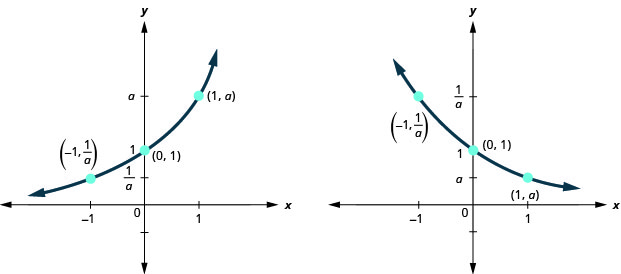 Compound Interest: For a principal, P, invested at an interest rate, r, for t years, the new balance, A, is
Compound Interest: For a principal, P, invested at an interest rate, r, for t years, the new balance, A, is when compounded n times a year.
when compounded n times a year.- A = Pert when compounded continuously.
- Exponential Growth and Decay: For an original amount, A0, that grows or decays at a rate, r, for a certain time, t, the final amount, A, is: A = A0ert.
is a function of the form f(x) = a^x where a > 0 and a ≠ 1.
A line which a graph of a function approaches closely but never touches.
The number e is defined as the value of (1+ [latex]\displaystyle \frac{1}{n}[/latex])n, as n increases without bound. We say, as n approaches infinity, e ≈ 2.718281827..
The natural exponential function is an exponential function whose base is e: f(x) = ex
The domain is (−∞,∞) and the range is (0,∞).

